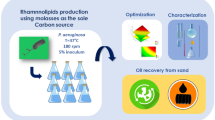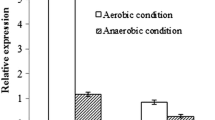Abstract
Rhamnolipids have been pointed out as promising biosurfactants. The most studied microorganisms for the aerobic production of these molecules are the bacteria of the genus Pseudomonas. The aim of this work was to produce a rhamnolipid-type biosurfactant in a bench-scale bioreactor by one strain of Pseudomonas aeruginosa isolated from oil environments. To study the microorganism growth and production dependency on oxygen, a nondispersive oxygenation device was developed, and a programmable logic controller (PLC) was used to set the dissolved oxygen (DO) concentration. Using the data stored in a computer and the predetermined characteristics of the oxygenation device, it was possible to evaluate the oxygen uptake rate (OUR) and the specific OUR (SOUR) of this microorganism. These rates, obtained for some different DO concentrations, were then compared to the bacterial growth, to the carbon source consumption, and to the rhamnolipid and other virulence factors production. The SOUR presented an initial value of about 60.0 mgO2/gDW h. Then, when the exponential growth phase begins, there is a rise in this rate. After that, the SOUR reduces to about 20.0 mgO2/gDW h. The carbon source consumption is linear during the whole process.








Similar content being viewed by others
References
Rahman, K. S. M., Banat, I. M., Thahira, J., Thayumanavan, T., & Lakshmanaperumalsamy, P. (2002). Bioremediation of gasoline contaminated soil by a bacterium consortium amended with poultry litter, coir pith and rhamnolipid biosurfactant. Bioresource Technology, 81, 25–32.
Rahman, K. S. M., Rahman, T. J., Kourkoutas, Y., Petsas, I., Marchant, R., & Banat, I. M. (2003). Enhanced bioremediation of n-alkane in petroleum sludge using bacterial consortium amended with rhamnolipid and micronutrients. Bioresource Technology, 90, 159–168.
Banat, I. M. (1995). Biosurfactants production and possible uses in microbial enhanced oil recovery and oil pollution remediation: a review. Bioresource Technology, 51, 1–12.
Parkinson, M. (1985). Bio-surfactants. Biotechnology Advances, 3, 65–83.
Desai, J. D., & Banat, I. M. (1997). Microbial production of surfactants and their commercial potential. Microbiology and Molecular Biology Reviews, 61(1), 47–64.
Gruber, T., Chmiel, H., Kappeli, O., Sticher, P., & Fiechter, A. (1993). Integrated process for continuous rhamnolipid biosynthesis. In N. Kosaric (Eds.) Biosurfactants (surfactants science series) (vol. 48, (pp. 157–173)). New York: Marcel Dekker.
Ma, F., & Hanna, M. A. (1999). Biodiesel production: a review. Bioresource Technology, 70, 1–15.
Cutayar, J., Poillon, D., & Cutayar, S. (1990). Process for the controlled oxygenation of an alcoholic fermentation must or wort. US Patent 4,978,545.
Santa Anna, L. M. M., Soriano, A. U., Gomes, A. C., Menezes, E. P., Gutarra, M. L. E., Freire, D. M. G., et al. (2007). Use of biosurfactant in the removal of oil from contaminated sandy soil. Journal of Chemical Technology & Biotechnology, 82(7), 687–691.
Jarvis, F. G., & Johnson, M. J. (1949). A glyco-lipid produced by Pseudomonas aeruginosa. Journal of the American Chemical Society, 71, 4121–4126.
Helvaci, S. S., Peker, S., & zdemir, G. (2004). Effect of electrolytes on the surface behavior of rhamnolipids R1 and R2. Colloids and Surfaces B: Biointerfaces, 35, 225–233.
Santa Anna, L. M. (2000). Produção de biossurfactante do tipo ramnolipídeo por Pseudomonas sp. M.S. thesis, Faculdade de Farmácia/Universidade Federal do Rio de Janeiro, Rio de Janeiro, RJ, Brazil.
Santa Anna, L. M., Sebastian, G. V., Menezes, E. P., Alves, T. L. M., Santos, A. S., & Pereira Jr., N., et al. (2002). Production of biosurfactants from Pseudomonas aeruginosa PA1 isolated in oil environments. Brazilian Journal of Chemical Engineering, 19(2), 159–166.
Santa Anna, L. M., Sebastian, G. V., Soriano, A. U., Gomes, A. C., Volpon, A., Freire, D. M. G., et al. (2004). Biossurfactante e uso do mesmo em remediação de solos impactados por óleo. Patent PI0405952-2, Petróleo Brasileiro S.A., Brazil.
Pham, T. H., Webb, J. S., & Rehm, B. H. A. (2004). The role of polyhydroxyalkanoate biosynthesis by Pseudomonas aeruginosa in rhamnolipid and alginate production as well as stress tolerance and biofilm formation. Microbiology, 150, 3405–3413.
ACS Committee on Analytical Reagents (2006). Colorimetry and turbidimetry. Reagent chemicals: Specifications and procedures10 edn, (pp. 32–41). Oxford: American Chemical Society–Oxford University Press.
Lowry, O. H., Rosebrough, N. J., Farr, A. L., & Randall, R. J. (1951). Protein measurement with the Folin phenol reagent. Journal of Biological Chemistry, 193, 265–275.
Charney, J., & Tomarelli, R. M. (1947). A colorimetric method for the determination of the proteolytic activity of duodenal juice. Journal of Biological Chemistry, 171, 501–505.
Braga, G. U. L., Messias, C. L., & Vencovsky, R. (1994). Estimates of genetic parameters related to protease production by Metarhizium anisopliae. Journal of Invertebrate Pathology, 54, 5–12.
Blanch, H. W., & Clark, D. S. (1997). Biochemical engineering. New York: Marcel Dekker.
Jeong, H., Lim, D., Hwang, S., Ha, S., & Kong, J. (2004). Rhamnolipid production by Pseudomonas aeruginosa immobilized in polyvinyl alcohol beads. Biotechnology Letters, 26, 35–39.
Benincasa, M., Contiero, J., Manresa, M. A., & Moraes, I. O. (2002). Rhamnolipid production by Pseudomonas aeruginosa LBI growing on soapstock as the sole carbon source. Journal of Food Engineering, 54, 283–288.
Haba, E., Espuny, M. J., Busquets, M., & Manresa, A. (2000). Screening and production of rhamnolipids by Pseudomonas aeruginosa 47T2 NCIB 40044 from waste frying oils. Journal of Applied Microbiology, 88, 379–387.
Author information
Authors and Affiliations
Corresponding author
Rights and permissions
About this article
Cite this article
Kronemberger, F.A., Santa Anna, L.M.M., Fernandes, A.C.L.B. et al. Oxygen-controlled Biosurfactant Production in a Bench Scale Bioreactor. Appl Biochem Biotechnol 147, 33–45 (2008). https://doi.org/10.1007/s12010-007-8057-3
Received:
Accepted:
Published:
Issue Date:
DOI: https://doi.org/10.1007/s12010-007-8057-3




